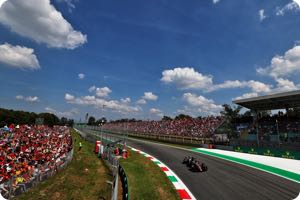JANUARY 10, 2024
Monza goes back to gravel run-off areas
The 21 million Euros investment the Italian government, the Lombardia region and the ACI are making on the modernization of the Autodromo Nazionale di Monza is mainly aimed at bringing the infrastructure up to the most recent Formula 1 standards, especially in the topic of providing a better experience for the paying fans, but will also focus on improving the racing conditions, as the changes made to the cars in the last change of regulations made this high-speed track less of a challenge than it was before.
During the lenghty ceremony in which the plans for Monza were shared with the media and the fans, it was shown that the ressurfacing of the track started right in front of everyone’s eyes, with the old tarmac being removed from a section of the pits straight and new tarmac being laid down, but other, more race-relevant plans, were also unveiled.
The most exciting one for the drivers is that the run-off areas for the first two chicanes of the Monza circuit will go back to featuring gravel, as it was agreed with the FIA this was the best course of action to take away the incentive to cut those chicanes, a resource used by many drivers in the last few years. While the majority of the run-off area in the first chicane had grass, there were two tarmaced routes the drivers could follow – one by going straight on and avoiding a few polysterine blocks placed there to force drivers to reduce speed before rejoining, the other, allowing to cut the second part of the chicane by going over a couple of small bumps – but in both cases there was a distinct advantage if you opted to go through any of them.
Now the second, smaller route, will disappear, as grass and that piece of tarmac will be replaced by gravel, which should be a massive deterrant for any driver thinking of making an optimistic move into the first chicane, as the margin for error will have been completely erased.
The same will happen in the chicane della Roggia, the second chicane, as the espace route that was possible to design for drivers who had missed their braking point was actually quicker than the real track, so, here too, gravel will replace tarmac and drivers cutting the chicane will have to go through it, losing time and, potentially, damaging their cars.
What needs to be checked is how it will be avoided that gravel will fly into the track once a car has gone off, the main problem we saw in the past and the main reason tarmac saw its way into those two run-off areas.
At the same time it was announced all the kerbs in the historic Italian circuit will be changed, as the current ones, with slopes, were considered a risk for the tyres and not fit for the purpose of helping the cars stay on track, with the new ones being from the same generation of those seen in the more modern circuits, tyre friendly but with low grip, to discourage their usage. That, combined with the new tarmac that will remove some of the track’s notorious bumps – particularly on the run down from Variante Ascari to the Parabolica Michele Alboreto – will change the nature of the track and will make this year’s Grand Prix Friday a learning day for drivers and teams alike.
